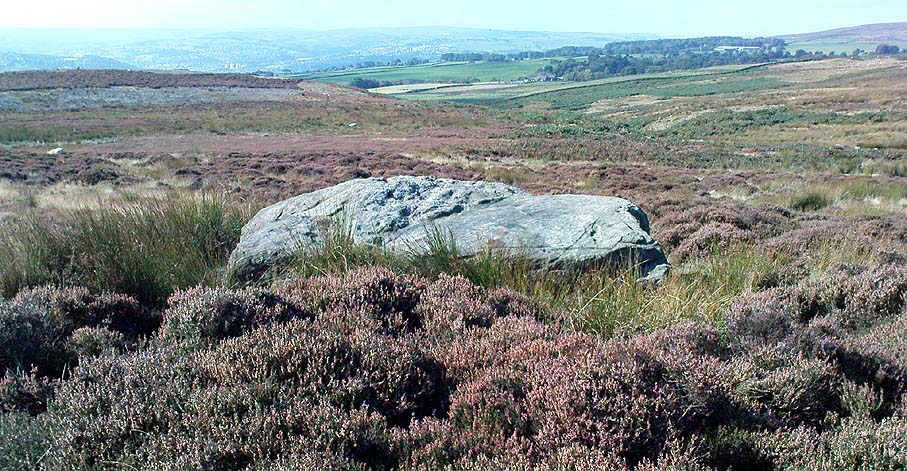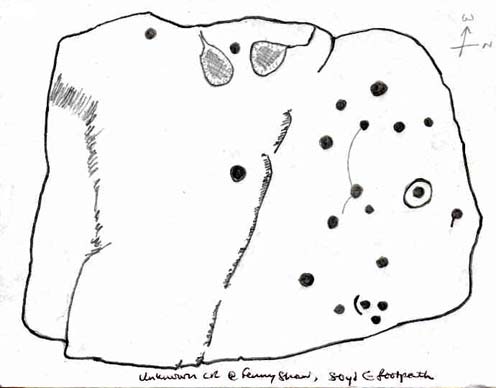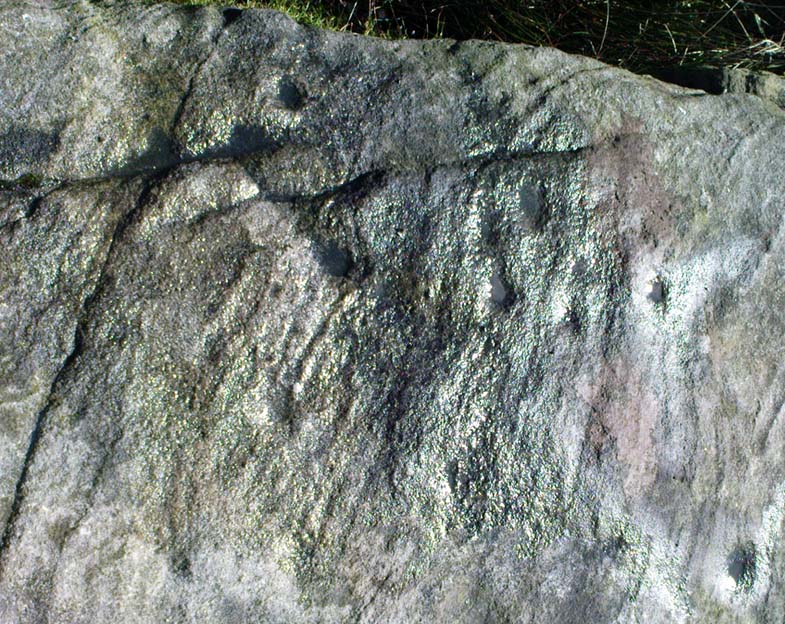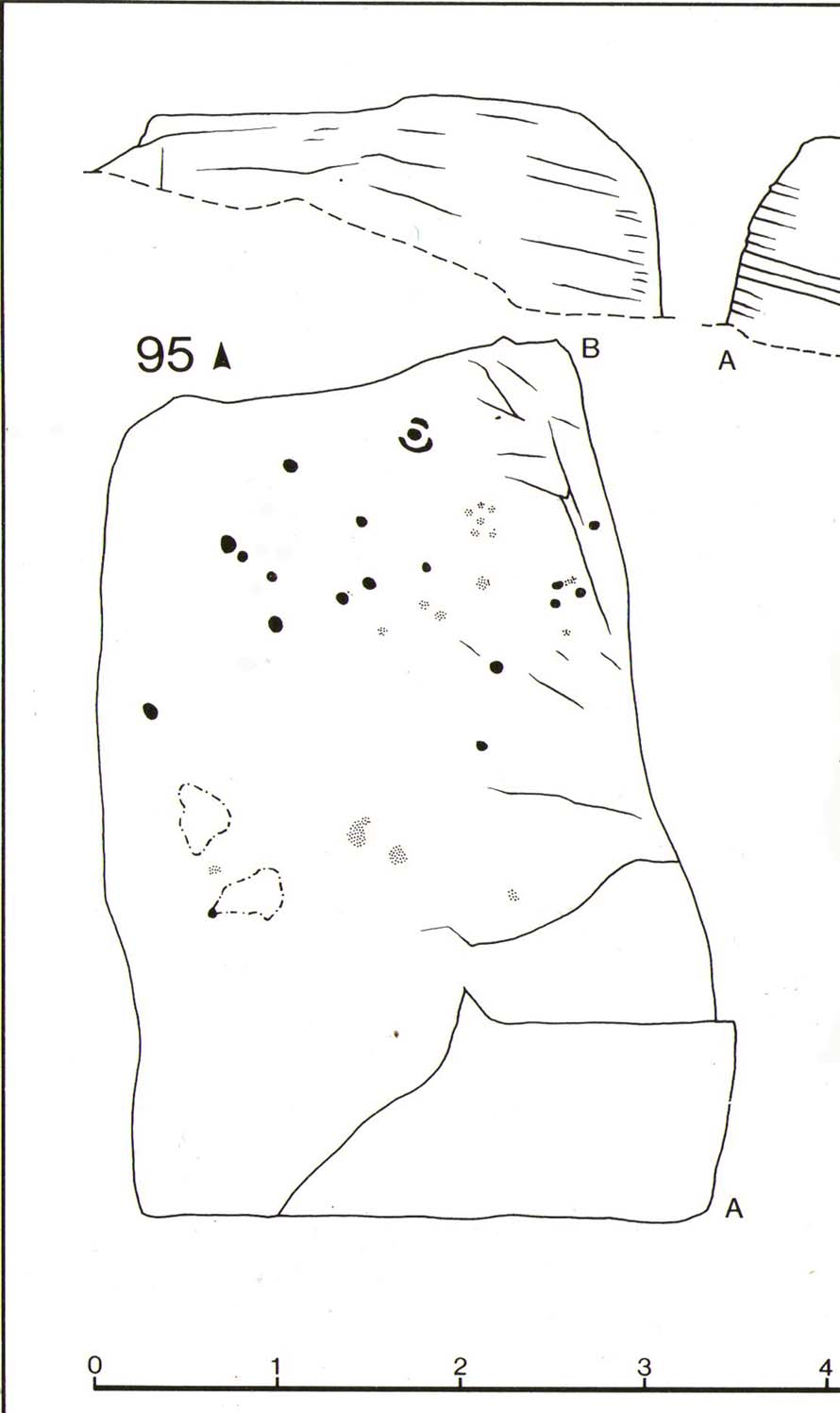Cup-and-Ring Stone: OS Grid Reference – SE 11203 43517
Also Known as:
- Carving no.95 (Hedges)
- Carving no.108 (Boughey & Vickerman)

The best and easist way to get here is to drive west past Dick Hudson’s pub along the moor road for about a mile till you reach the left turn of Heights Lane. Stop here! (if you’re now going downhill to East Morton, you’ve gone past it) On the opposite side of the road is a gate and a footpath onto the moor at the spot called Fenny Shaw Low Well (small copse of woods adjacent to your right). Walk a quarter-mile up the path, bearing left where the path diverges (ignoring the ‘Private’ sign) and head for the derelict building. Less than 100 yards before it, notice the large boulder to your right, on the slope – that’s it!
Archaeology & History

I first came across this on one of my countless ambles on these moors as a teenager. It was a cold, windy day as I recall – hence the reason for my sketch of the stone being a bit vague! The bit of paper on which I drew it, was included in one of my unpublished hand-written booklets. A few years later an image of the carving appeared in Mr Hedge’s (1986) fine collection, in much better detail than my scratty little pic!

It’s a ‘big rock’ and stands out on the slope here. There’s at least one complete cup-and-ring which is visible on the northern edge of the rock and there are between 17 and 30 other cups scattered across its surface, which has been greatly eroded by our timely forces of wind, rain, ice and snow.

In ambling around looking at the other stones in the vicinity, along with finding the small Littlestone cup-marked rock further up the slope, we also found, just below the faded old Big Stone, another quite large rock upon which, quite recently, someone has decided to etch four complete cup-and-ring symbols. These appear to have been done either to,
i) assess degrees and speed of erosion on rock carvings;
or,
ii) pure artistry.
Whichever it may be (and there’s been various cries of “vandalism” when such carvings have been etched by some folk on otherwise virgin rock over the years), let it be known that the Big Stone’s partner was etched c.2008-9. Does anyone out there know who did this ‘new’ carving?
References:
- Boughey, K.J.S. & Vickerman, E.A., Prehistoric Rock Art of the West Riding, WYAS: Leeds 2003.
- Hedges, John (ed.), The Carved Rocks of Rombald’s Moor, WYMCC: Wakefield 1986.
© Paul Bennett, The Northern Antiquarian
The map could not be loaded. Please contact the site owner.
Big Rock (IAG108): worth mentioning that also several ‘bullet holes’ on sides, particularly to West. Almost certainly of WW2 origin when the moors were a large training ground. I mention this in case someone in the future thinks they are ‘cup marks’
When in the area, it’s worth mentioning carved rock IAG112 (Boughey and Vickerman) just up the slope 82.4 metres, 54.5 degrees(True) from IAG108 (Big Rock). Boughey & Vickerman: “Large rough rock. Two possible cups on top and one further possible cup on W vertical face. Doubtful”. Trace a line back through 108 from this rock and it projects back to the main carved rock group on Stanbury Hill, possibly through IAG96. Coincidence?
Re ‘Experimental Carved Rock’ about 4m/260 degrees(True)below IAG108, these carvings (with initials of the four carvers, was executed using a stone and hammerstone as part of an academic study into execution and erosion – but a few years before the date suggested above. It’s a pity that one of the carvings appears recently to have been defaced. Perhaps if the executors had made their existence more widely known (and dated them), this damage might not have occured. Some might question the experiment and future possible confusion with ‘the real thing’.
Hi there!
“When in the area, it’s worth mentioning carved rock IAG112 (Boughey and Vickerman) just up the slope 82.4 metres, 54.5 degrees(True) from IAG108 (Big Rock). Boughey & Vickerman: “Large rough rock. Two possible cups on top and one further possible cup on W vertical face. Doubtful”. Trace a line back through 108 from this rock and it projects back to the main carved rock group on Stanbury Hill, possibly through IAG96. Coincidence?”
Coincidence? I’d say so. Unless there’s summat I’m missing here. Cup&rings simply don’t play a part in alignment features on this moor. Indeed, with very few exceptions (Newgrange sunrise, carvings on lunar standstill recumbents) cup&rings don’t fit into alignment features at all. I’d love to be shown otherwise though.
atb – Paul